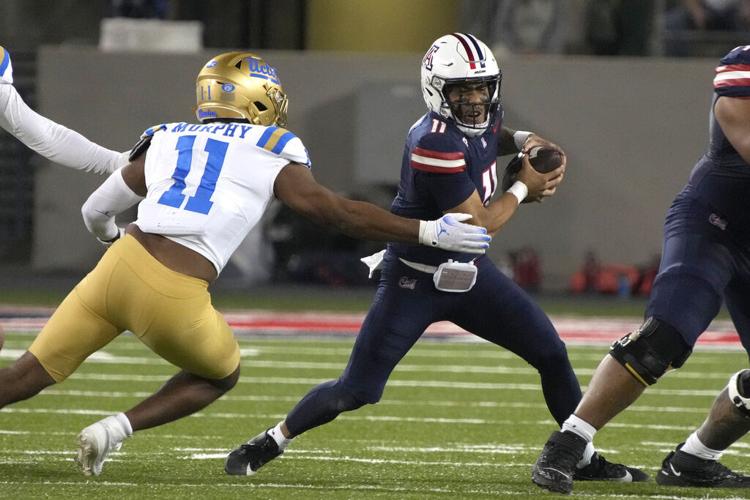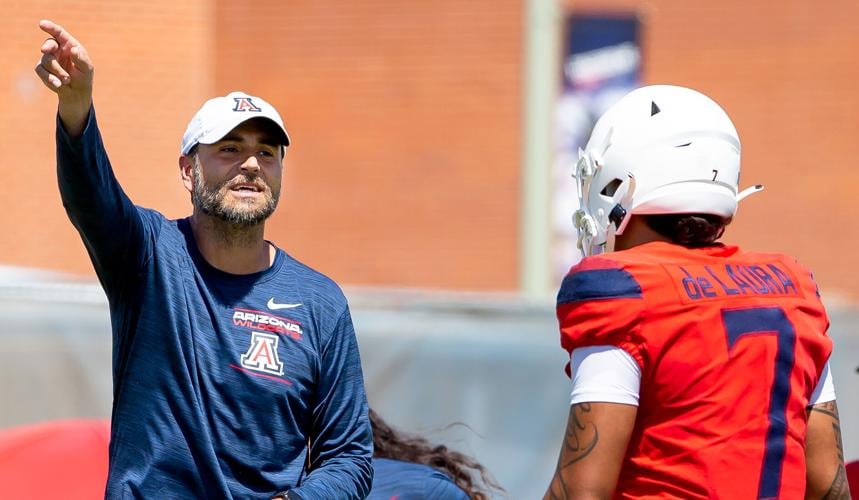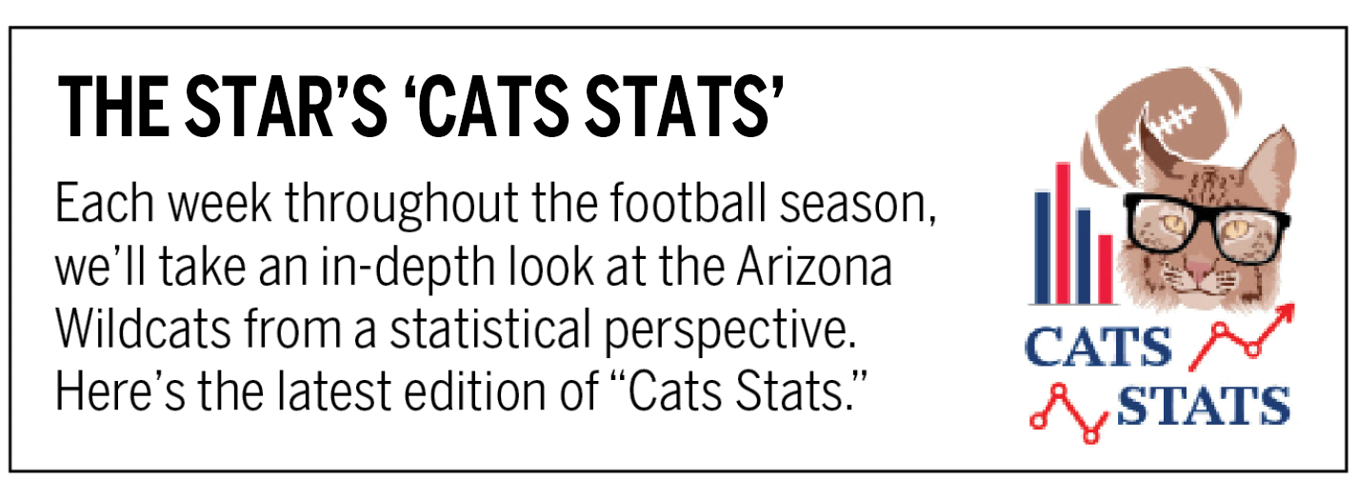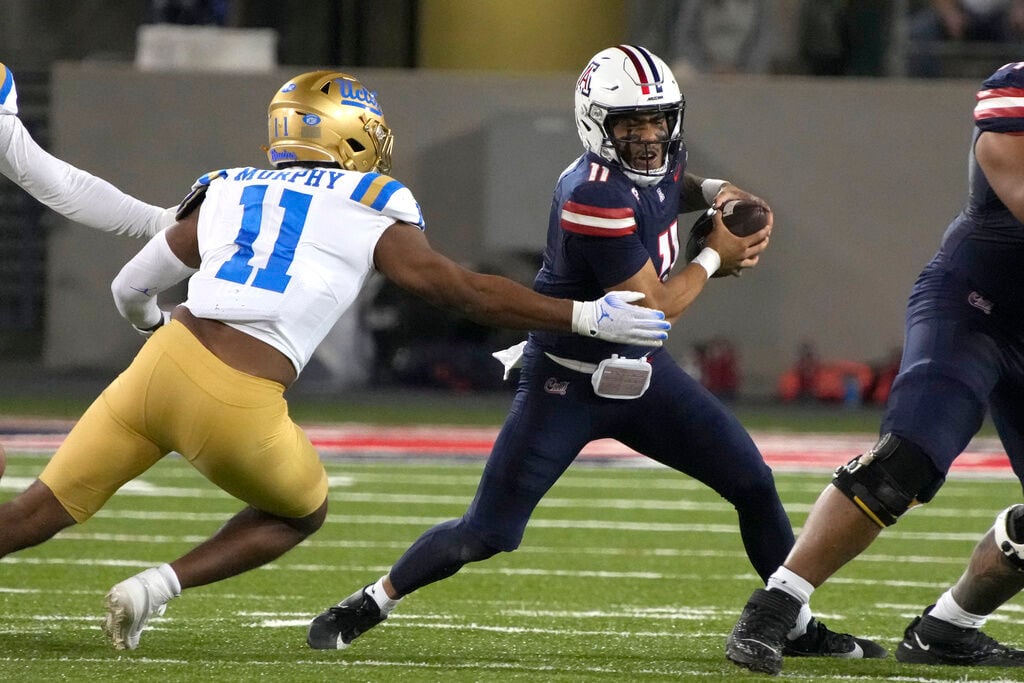The Arizona Wildcats have improved in so many areas during their breakthrough 2023 college football season; it’s hard to keep up with them all.
We’re going to attempt to narrow it down for you in this week’s “Cats Stats,” focusing on one aspect on each side of the ball. If not for the gains they’ve made in these parts of the game, the No. 21-ranked Wildcats wouldn’t be sitting at 6-3 as they head to Boulder to face Deion Sanders and Colorado on Saturday.

Cats climb on 3rd down
The first area is third-down offense. Over the past four games — the triple-overtime loss at USC and wins over Washington State, Oregon State and UCLA — Arizona has converted third downs at a 56.7% clip. Over the previous five games, that number was 37.7.
That leap has enabled the Wildcats to climb to 17th nationally, one spot ahead of Alabama, with an overall conversion rate of 47.8%. Their improvement in that category correlates with the program’s growth under Jedd Fisch. In 2021, Arizona finished 119th nationally in third-down conversion rate at 32.6%. Last year, the Wildcats were 38th at 41.2%.
Arizona’s newfound ability to sustain drives has enabled the Wildcats to dominate time of possession over the past four games. Arizona has had a positive margin of at least 10 minutes, 28 seconds in three of the four. It had a 1:32 edge vs. OSU. In the first five games, the Wildcats had two TOP deficits, two positive margins of less than a minute and one at plus-4:44 (Mississippi State).
What’s behind all this? It’s more like who’s behind it.
In separate media interviews this week, UA offensive coordinator Brennan Carroll and quarterback Noah Fifita credited Jimmie Dougherty, Arizona’s QB coach and passing-game coordinator.
“Coach Jimmie Dougherty has done a fantastic job,” Carroll said. “It’s his focal point during the week. And the guys have just taken to the details, being on your assignments, understanding the exact down and distance, the situation, knowing where the sticks are.
Fifita agreed, saying it’s “definitely” the coaching staff that’s responsible.

Arizona quarterbacks coach Jimmie Dougherty (pictured, left, during a 2022 UA practice) is the architect of the Wildcats’ third-down offense, which has been hugely successful during the team’s surge into the Top 25.
“(Dougherty) is the one that does the third-down presentation, the third-down breakdowns for us, breaking down fronts and coverages for us in certain downs and distances,” he said. “So the time he puts in, the game plan that Coach Fisch puts in.
“And then it goes back to trust. We trust it. We trust that their insight, that the information they’re providing us is right. It’s been spot on … and that’s why we’ve had a lot of success on third downs and a lot of success in general.”
Fifita has made a significant difference too. His third-down numbers basically mirror his stats on all other downs.
Fifita has completed 44 of 56 passes (78.6%) on third down for 420 yards (7.5 ypa) with three touchdowns and one interception, per ESPN.com. Teammate Jayden de Laura, whom Fifita replaced starting in the fourth quarter of the Stanford game, is 13 of 24 (54.2%) on third down for 90 yards (3.8 ypa) with one TD and two picks.
Neither Fifita nor Arizona performed well on third down in his first start against Washington (4 of 12, 33.3%). They’ve been sharp ever since, including a season-best 11-of-16 performance (68.8%) against a stingy UCLA defense. The Wildcats repeatedly converted against the Bruins despite a season-high average-to-go of 8.8 yards.
Usually, the fewer yards you need, the higher your conversion rate is. That hasn’t been the case for the 2023 Cats. Their average distance on third down in the first five games was about 5.7 yards. It’s about 6.8 over the past four games.
Credit Fifita (who converted a third-and-10 vs. UCLA with a nifty 18-yard scramble) and the coaches’ game-planning/play-calling (which featured a third-and-6 run by Jonah Coleman that caught everyone, including the Bruins, by surprise).
Red zone ‘D’ rockets up
Complementary football has been a theme of Arizona’s resurgence, and the defense is doing its part — especially in the red zone.
The Wildcats had one of the feeblest red-zone defenses in the country the past two seasons. In 2021, they allowed touchdowns at a 76.3% clip, which ranked 128th nationally. Last year, that number was even worse — 79% (130th).
This year it’s at 51.4%, which ranks 37th nationally.
The past two games have lowered that number. Arizona held Oregon State to a 50% TD rate (2 of 4) and UCLA to a 20% clip (1 of 5).

Arizona defensive back Treydan Stukes, left, forces UCLA wide receiver Logan Loya to lose his grip on a catch, stopping a Bruin drive in the third quarter of the Wildcats’ third consecutive win over a ranked opponent on Nov. 4, 2023, at Arizona Stadium.
The Bruins did have a made field goal and two misses (including a block by Ephesians Prysock). Those are all wins for the defense.
Arizona’s “D” hadn’t performed that well in the red zone since the nonconference portion of the schedule, during which the Wildcats limited NAU, MSU and UTEP to two touchdowns in nine trips. The defense got off to a hot start in the red zone last year too, allowing just one TD in four trips to San Diego State. From that point forward, opponents practically scored at will: 44 TDs in 53 trips (83%).
The red zone, on both sides of the ball, was a huge point of emphasis at the start of training camp. It remains a focal point.
“We practice it every single day,” defensive coordinator Johnny Nansen said. “If you’re gonna be good at something, you gotta practice it.”
Defensive back Treydan Stukes sees a common thread between the Wildcats’ red-zone success on defense and third-down success on offense.
“I think it just all goes back to trust,” Stukes said. “Our coaches are experienced. They’ve seen so much football. So just being able to understand the mental side of the game that they’re teaching us and executing the game plans that they’re giving to us. That’s what it’s been about. That’s how we’ve been able to take that step forward.”
Arizona quarterback Noah Fifita and defensive back Treydan Stukes talked about the culture change at the UA under Jedd Fisch, and the upcoming matchup with Colorado. Video by Justin Spears / Arizona Daily Star








